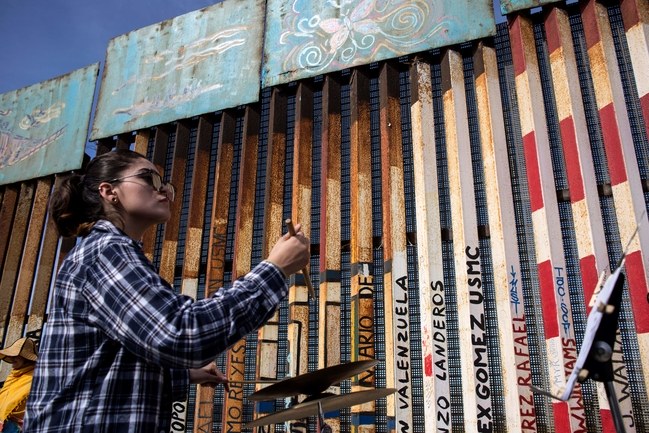On Saturday, the percussionist and conductor Steven Schick looked through the wire-mesh fence that separates San Diego, California, from Tijuana, Mexico, and said, “Con la música nunca se puede dividirnos”: “With music, we cannot be divided.” He was addressing a group of Mexican percussion players, who were about to participate in a singular cross-border performance of John Luther Adams’s hour-long percussion work “Inuksuit.” I was standing on the Mexican side, where the wall is adorned with brightly colored graffiti and studded with messages, some sentimental and some political. On the reverse, a gray, institutional look prevails. We were on the far western edge of the U.S.-Mexico border. The land slopes down to the Pacific Ocean, and the wall descends with it, disappearing into the waves.
Not surprisingly, the project of presenting an avant-garde concert in this politically fraught territory proved to be a logistical challenge. It almost didn’t happen: the San Diego Symphony, which presented the event, had been on the point of cancelling it when, at 4 p.m. last Wednesday, final approval came through from the U.S. Border Patrol. Weather had further complicated the undertaking: the torrential Southern California rains that caused deadly mudslides to the north had washed out roads on the American side, making access difficult.
Schick, a longtime member of the faculty at the University of California, San Diego, had conceived of a border performance nearly a decade ago, when he was preparing for the world première of “Inuksuit,” in Banff, Canada. You can actually see the concept flitting through his head in a video that Evan Hurd made for The New Yorker in 2009. (See 6:30.) Schick said to me that, in San Diego, “we often don’t even think consciously about the border here, because it’s so much a part of our lives. Not to sound too much like Sarah Palin, but I can actually see Mexico from the end of my street. When I started working on ‘Inuksuit,’ this idea immediately occurred to me. John’s piece is about sound moving around in whatever geography it takes place in. What would it say about this rocky land by the ocean, which has a human line running through the middle of it?”
Around two years ago, Schick began talking to Martha Gilmer, the C.E.O. of the San Diego Symphony, about curating a percussion-centered festival, which they eventually called It’s About Time. It involved not only a series of concerts by the orchestra but also allied events by more than a dozen other organizations, including the San Diego Opera. “It turned out that we needed the institutional strength of the orchestra to make this happen,” Schick said. “Given the advent of Trump and the tensions surrounding the wall, the Border Patrol rejected a lot of proposals. A German orchestra wanted to do a protest concert, and were turned down. But we convinced them that this wasn’t a purely political gesture. I’d thought of this long before Trump became an issue. The work was a wedding present for me and my wife, Brenda. It’s very personal for me, and I wanted it to be heard first as music, not as a statement.”
That said, politics was on everyone’s mind, and provoked media interest. Al Jazeera sent a film crew to document any signs of resistance. Schick has not been timid on the subject of Trump: on Inauguration Day, he made a statementin conjunction with a concert he was conducting in San Francisco. He declined, however, to describe the “Inuksuit” event as a protest. He told me, “One could be forgiven for having all kinds of political thoughts. But I’m mindful of the fact that Border Patrol went out of their way to make this happen. After the rain, they opened their own roads to us so our musicians could get their instruments to the fence.”
On Saturday morning, I drove south with Gilmer to the crossing point at San Ysidro. A corrugated-metal wall, erected during the Clinton Administration, runs along the border for fifteen miles. As it snakes up and down hills, it looks like a junk-metal imitation of the Great Wall of China. “I’ve seen a few walls in my time,” Gilmer said. For decades, she worked at the Chicago Symphony, and travelled to the demilitarized zone between North and South Korea and to the former border between East and West Berlin. The Berlin Wall makes for an interesting comparison. There, you saw colorful graffiti on the western side and featureless concrete on the eastern.
Hundreds of cars were waiting in long lines to cross the border into the United States. Tacos, sodas, knickknacks, and, curiously, puppies are for sale as people wait. We parked and proceeded on foot, to avoid the delay coming back: it can take hours to pass through on the weekend. The border area is chaotic, with hulking new facilities under construction. Prototypes for Trump’s border wall are on display just north of the fence on the American side.
In Tijuana, a festive atmosphere reigned. It was a bright, warm day, and several hundred people were milling around next to the wall. This area and the adjacent American zone together form a place called Friendship Park. At the center stands Boundary Monument No. 258, a historical marker that went up after the end of the Mexican-American War. First Lady Pat Nixon dedicated the park, in 1971, saying, “I hope there won’t be a fence here too long.” At that time, a low three-wire fence separated the two countries. In recent decades, the wall has steadily grown in bulk, and a second fence was added on the American side, creating a no-man’s-land strip, which is open only on weekends. The mesh was made thicker, to prevent the passing of drugs and other contraband. Gilmer greeted her husband and son by touching pinky fingers. Schick gave a quick pep talk to the ensemble: thirty-five players to the north, twenty-nine to the south.





